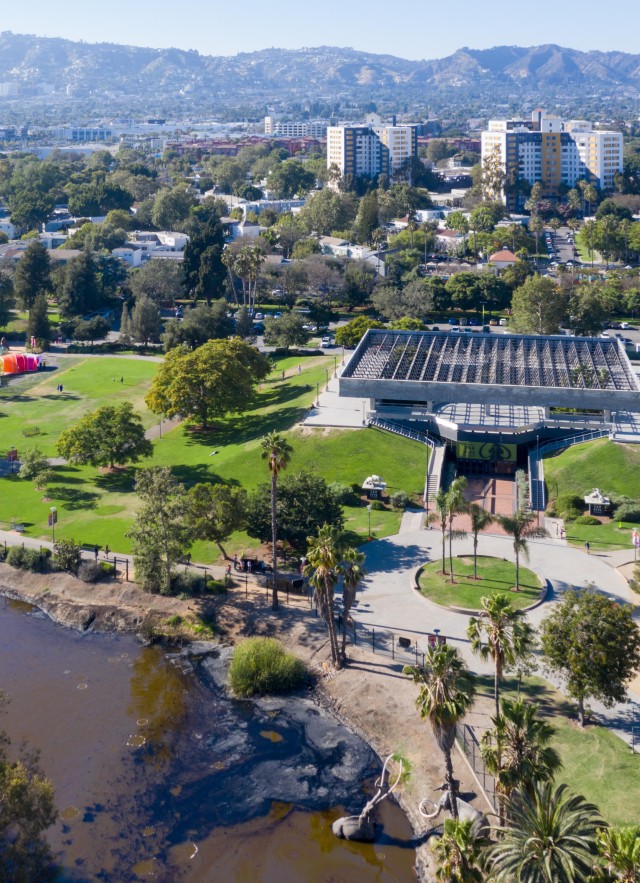The museum will be closed Thursday, January 1 for New Year's Day. We will reopen Friday, January 2.
La Brea Tar Pits Selected as One of First 100 Geological Heritage Sites
Iconic L.A. fossil site is recognized by the International Union of Geological Sciences.

The La Brea Tar Pits in Hancock Park has been selected as one of The First 100 IUGS Geological Heritage Sites named by the International Union of Geological Sciences (IUGS), one of the world’s largest scientific organizations representing over one million geoscientists from more than 120 member countries.
In October 2022, IUGS celebrated its 60th anniversary with a conference in Zumaia, Basque Coast, Spain, at the UNESCO Global Geopark, and made the formal announcement of The First 100 IUGS Geological Heritage Sites. A new designation similar to UNESCO’s World Heritage Sites, IUGS Geological Heritage Sites are key places with geological elements and/or processes of international scientific relevance and those that represent a substantial contribution to the development of geological sciences through history and understanding of the Earth. La Brea Tar Pits have been identified by IUGS as the richest Pleistocene (“Ice Age”) fossil site on Earth, and as the key paleontological site that has shaped the understanding of this time period for both scientists and the public.
“Beloved by Angelenos and known for capturing the imagination and inspiring pop culture from the current La Brea TV series to the Ice Age animated films, La Brea Tar Pits is a one-of-a-kind site for scientific research into the past with important data for understanding climate change in our own time,” said Dr. Lori Bettison-Varga, President and Director of the Natural History Museums of Los Angeles County, which oversees La Brea Tar Pits as an active field site and museum. “This acknowledgement from the international scientific community is recognition of La Brea’s gifts to science and the hard work of paleontologists, preparators, and volunteers during its more than 100 years of research and excavation.”
La Brea Tar Pits is a gateway to the Ice Age, a living laboratory for the local and global community to discover groundbreaking research and watch paleontologists dig for plant and animal fossils trapped in asphalt seeps over thousands of years. La Brea Tar Pits is the only ongoing, urban Ice Age excavation in the world. This makes the site a unique window into active science—where fossils are discovered, prepared, researched, and displayed in one place. Outside, visitors can watch fossils of the wildlife trapped in the seeps being unearthed. Inside the Museum, scientists and volunteers clean, repair, identify, and study those very fossils. The best specimens are displayed and all of them are available for research: from extraordinary saber-toothed cats, giant sloths, dire wolves, mammoths, and mastodons—to microfossils of small animals and plants. These collections and the locality constitute an unparalleled resource for understanding environmental change in Los Angeles, and the planet, during the last 50,000 years of Earth’s history, and have been the subject of more than 400 scientific publications.
La Brea Tar Pits was formed through multiple intervals of uplift and faulting, allowing crude petroleum to seep to the surface from underground reserves over the last 50,000 years, creating shallow pools that entrapped and preserved millions of fossils representing hundreds of species of plants, invertebrates, and vertebrates. It has been the subject of intensive research on geology, paleontology, and archaeology for over 150 years. In 1951 it was designated as the type locality for the Rancholabrean North American Land Mammal Age (NALMA), meaning it is the site of reference for fossils found between 240,000 and 11,000 years ago in North America. The site was also formally recognized by the United States National Parks Service as a National Natural Landmark in 1963.
The significant IUGS designation happens at a noteworthy time. A planned expansion of the Tar Pits’ 13-acre campus has been in the works since 2019, when the Natural History Museums of Los Angeles County, through a public competition, selected the world-renowned architecture firm Weiss/Manfredi to create a master plan to improve research facilities and collections space, expand exhibits, and unify the various elements of the site—the Lake Pit, the tar pits, the lawn, and the museum at La Brea Tar Pits (established in 1977 as the George C. Page Museum). The master plan developed with Weiss/Manfredi is a multi-year process of public engagement, master planning, design, and future construction at the Tar Pits’ campus, which encompasses its asphalt seeps, surrounding parkland, and the George C. Page Museum building.
“The plan to reimagine La Brea Tar Pits aims to demystify the science and seize this opportunity to educate visitors about the impacts of climate change, in the past and now,” added Dr. Bettison-Varga. At the heart of the plan is NHMLAC’s promise that La Brea Tar Pits will remain inclusive and accessible to all—whether it’s a child marveling at just-unearthed fossils at the Tar Pits or a neighbor jogging past the still-oozing asphalt.”
Today, research at La Brea Tar Pits ranges from traditional descriptions of fossils, to studying the biology and behavior of extinct animals, to investigating how ecosystems have been altered under changing climatic conditions over the past 50,000 years. This last research focus has particular urgency, as it can provide critical baselines for understanding how plants and animals will be impacted by modern, human-caused climate change.